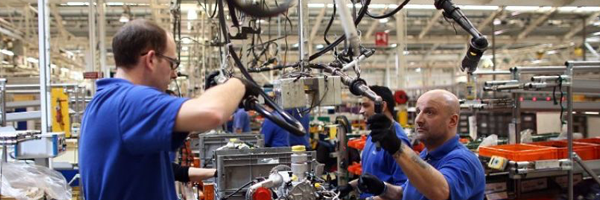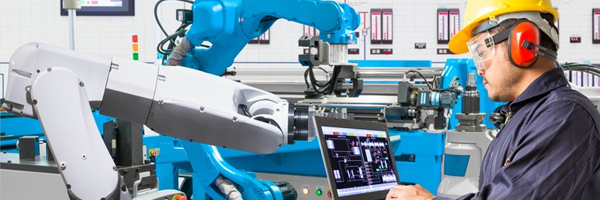The application of advanced analytics around your production, maintenance and supply chain could deliver annual business growth of between 4% – 10%; but achieving that means getting the basics right first.

The vast majority of UK manufacturers, some 92%, believe that smart, connected technology will enable their business to increase productivity levels per headcount, according to the Annual Manufacturing Report 2018.
Almost the same number, 91%, believe that data-driven insights from connected machines and people will inform their decision-making, drive efficiencies and reduce costs.
Furthermore, 89% believe digital technology will enable staff to work smarter, and 80% believe it will improve their supply chain relationships.
These are huge figures, and demonstrate quite conclusively that the argument for digital technology and its adoption has been won.
However, there would appear to still be a significant disconnect between an organisation merely seeing the value of data and one which is proactive leveraging that value and turning it into competitive advantage.
Digital transformation? Box ticked!
This disconnect is being compounded by those businesses who have already adopted – historically or more recently – some form of basic data capturing or business intelligence system and believe that that provides them with a big data, advanced analytics and data-driven insight capability.
I’m sure ‘Dave’ down the hall can work wonders with a spreadsheet, for example, and provide the management team with all the information, insight and reporting they think the business requires.
But, does a spreadsheet – a more than 30-year-old piece of software – genuinely represent an appropriate response to what today’s digitalisation of manufacturing can offer?
Absolutely not, says Tim Clark – Head of Manufacturing at one of the world’s foremost analytics and data management service providers, SAS.
“When we talk about getting the basics right, it’s not just about getting the basics of data and process in order,” Clark explains. “It’s also about getting the right tool kit in place, the tools your business will use to drive greater insights, value, customer experience and ultimately, growth.”

The economic value of data & analytics
In 2016, SAS published the results of study exploring the value of big data, analytics and the Internet of Things (IoT) to the UK economy.
The key takeaway was that between 2015 and 2020, approximately £320bn worth of benefits were set to be added to the UK economy, of which manufacturing was set to benefit from around £27bn.
We are currently halfway through the study’s timeline and the distance travelled so far has been encouraging and largely mirrors that which was forecast.
“In the past two years, there has certainly been a significant change in attitudes towards where value is created and held within a business,” notes Clark.
“Research such as ours has helped drive an understanding towards value not only being in data, but also in the application of analytics and advanced analytics such as artificial intelligence and machine learning to gain deeper insight into operational processes, i.e. production, supply chain, digital marketing and post-sale service offerings.”
To help manufacturers get back to basics, SAS has defined a matrix around the four key business processes data can improve today and help futureproof for tomorrow: ‘Make’ for manufacture, ‘Plan’ for supply chain, ‘Engage’ for customer experience, and ‘Service’ for post-sales services (servitization).

“Linking these processes together allows a business to drive much greater insight, agility and flexibility across your operations, and pairing this with data-driven analytical approaches and real-time monitoring will deliver a much higher level of efficiency enterprise-wide,” Clark notes.
How to define your data strategy
If the argument for digital technology and its adoption has been won, if the business value of data-driven insights and analytics has been made clear, then why are so many organisations still failing to pull the trigger on investments?
One reason may be that many boardrooms are struggling to define how business’ digital roadmap or the potential return on investment (RoI). Digital technology and data has fundamentally effected every single task, business function and department – from purchasing and HR to production, distribution and customer service.
That’s a good thing; it means that there a wealth of opportunities to drive incremental efficiency improvements and drive cost-savings. The flipside, however, is that integrating digital and data analytics can be an overwhelming project to undertake.
“Keep things simple,” Clark advises. “If your processes are complicated, simplify them. Whether you’re making a jet engine or a paperclip, the fundamentals of what your business does is make something, move it into your supply chain, market it, engage with your customers, sell it and offer some form of post-sales service capability.
“Time spent breaking down that process in your own business is never wasted.”
“Every customer engagement SAS has starts with the business problem,” he adds. “Getting the business problem clearly identified, articulated and captured is the crux of success. Being able to then look at the type of data that influences that, the data that can augment that and how that data can be consistently enriched are the three key steps around data management and data integration.”
Clark’s second piece of advice is to build your digital strategy on a scalable platform, something that can adapt to change and support your business as it evolves and grows.
“Data is always changing; therefore, your business has to plan and adapt to accommodate such changes,” he says. “Manufacturers need a platform that allows the easy input or gathering of data, which can then be checked, cleansed, integrated, interrogated and ideally all of these steps would be automated.”
Outdated and antiquated
What about those manufacturers who are already on their digital journey? Does Clark have any advice for businesses which have, in some cases, been gathering, storing and utilising data for some time now?
“A surprisingly large number of organisations who started to engage with data many years ago haven’t changed their processes,” he says. “That’s compltetly the wrong approach, it’s outdated and antiquated.
“The way that the proliferation of data happens second by second, even millisecond by millisecond, not to mention the rapid advances in analytics, artificial intelligence and machine learning, means a business has to be agile and flexible. Which supports my point about the need for a scalable, capable platform which can support your business growth.”

